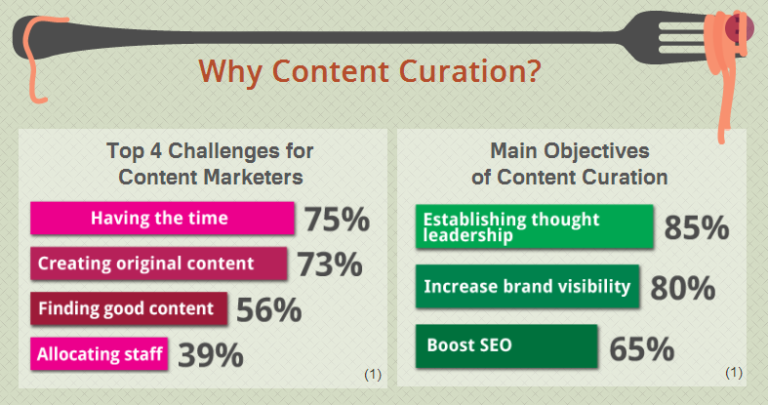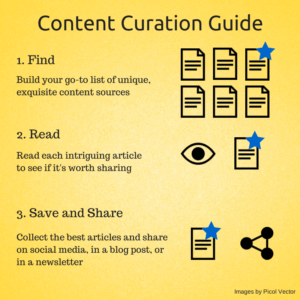You are viewing our site as a Broker, Switch Your View:
Agent | Broker Reset Filters to Default Back to ListUltimate Guide to Content Curation
August 15 2017

In 2016, there were approximately 3,424,971,237 Internet users worldwide – and the number is increasing rapidly. The billions (yes, BILLIONS!) of people that are on the Internet are doing all sorts of things from streaming movies, publishing blog posts, online shopping, scrolling through Facebook feeds, talking to friends across the ocean – the list truly can go on and on. A lot of these users are creating something – also known as "content" – to put on the Internet for others to see and engage with. Whether it's for personal or professional use, there's a high volume of content at our disposal at all times.
However, with the average user demanding more content on a daily basis, it's hard, especially for businesses, to keep up. So, what do individuals and businesses do when they're too busy or out of ideas for fresh and unique content?
Content curation. The ultimate move.
Read on to learn more about why.
What Is Content Curation?
Content curation isn't exactly a new concept, so you may have some idea of what it is, but in case you don't, we'll give you the 411.
According to Lifewire, content curation is defined as "when you review content from a variety of sources, gather links to those sources, share descriptions of that content, add your own commentary to that content, and publish all of those pieces in a single location."
They key part of this definition is sharing descriptions of that content and adding your own commentary to that content. This is what makes content curation different than content aggregation or content syndication.
Content aggregation is defined as "when you gather links to content and provide nothing else but those links," whereas content syndication is defined as "the process of pushing your blog, site, or video content out into third-party sites."
We know that content curation can be a confusing topic and a timely process, but it's essential to understand in order to promote growth and increase online presence, among other things.

Why to Curate
Here are just a few reasons to spend your valuable time curating content:
1. It Diversifies Your Content Portfolio
It's impossible to have the answer to it all – which is where content curation comes in handy. Collecting original data, creating entirely unique topics, and spending the time on sites handpicking the perfect articles can be inefficient and exhausting. By collecting various data points, links, and images and condensing into one post, you are providing your audience with information that they would not otherwise come across on your website alone, making you a key source in their newsfeed.
2. Save Time and Energy
While content curation itself can be a time consuming process, if you utilize the proper tools and become familiar with the steps, it will take you less time to find and select the appropriate content. Additionally, when you become a content curation pro, you'll have enough content in your back pocket that you can pull from it. This will ultimately save you time in the future because you won't need to create a whole new piece.
3. Be an Industry Expert
When you simplify information and include additional comments, you're positioning yourself as an industry expert. With many companies and individuals attempting to accomplish the same goal, it's important to add something unique that isn't already on the web. By creating your own content based on what you found important for your audience and adding your own thoughts, you are becoming a trusted industry expert.

Tips to Curate:
Now that you're well-versed in what content curation is and why it's important, here are some tips on how to get started no matter the channel you're using!
1. Learn About Your Audience
In order to provide valuable content that your audience will find worthy of engaging with, it's imperative that you understand their preferences, interests, and needs. They are looking to you to provide certain information related to a specific topic, industry, or product – which means that if you are unable to, they will likely go somewhere else.
It's important to create a marketing persona that will allow you to learn about your audience, provide them with that they want, and keep them coming back for more.
2. Collect From Reliable Sources
Just because it isn't your original data or information doesn't mean that accuracy is any less important. It's necessary to collect data, images, and links from accurate and reputable sources that will allow you to present your audience with the most quality links and visuals.
Consider using a tool like Feedly that will allow you to choose your news sources and keep them organized in one area for easy browsing with the confidence that you're using trusted sources.
3. Read Before You Share
This seems like an obvious tip, but you would be surprised how often individuals repost or include articles that have no relevance to their target audience. Ensure that you're sharing only the most valuable information to your audience so that they continue to rely on you as a trusted source.

Where to Curate
There are some places that are more "content curation friendly" than others. Namely, social media, blogs, and newsletters are considered curation friendly, given that they have platforms that have a broad reach and are conducive to providing extensive comments as well as fostering dialogue.
Social Media:
Although it's still a powerful distribution channel, curating content on social media can sometimes be more challenging than others.
First, because social media platforms (such as Twitter) have a character limit, it is more challenging to fit all insights and comments into one post. Second, since different social media platforms have different uses, they convey different messages, making it challenging to streamline your social media efforts. Third, since there are various social media posts, it is incredibly easy to share, retweet, or repost rather than adding to the conversation, making it challenging to be inspired to add your own.
The key to social media content curation is going above and beyond tweeting out a link (this is considered aggregation!). It's about posting something on social media and elaborating on it by providing comments and insights and contributing to the overall conversation.
Check out our tips for how to curate content on the three biggest social media platforms!

Twitter:
Since Twitter has limited characters, it's slightly more challenging to curate in the traditional way (posting a link, providing additional thoughts, etc.). Twitter should be used to share a link or an infographic, and provide a quick thought that sparks a conversation. A one sentence summary, or highlighting a key point then asking your audience what they think, what they would add, or how it affects their daily lives is a way to spark a conversation.
The real content curation will occur when you respond to your audience and offer ideas, highlight additional points, and continue the conversation while expanding on the article.
Instagram:
A picture is worth a thousand words, which is where a platform such as Instagram, which relies heavily on images and video rather than text to tell a story or express an opinion, is valuable. Instagram stories, albums, and even unique images such as infographics or charts are a few examples of how to curate content for Instagram.
However, it does have some drawbacks. Specifically, image size, inability to easily link to other articles, products or websites, and provide insights other than in the comments, makes Instagram a less versatile platform.
As a result, it's recommended that Instagram be used to tell a visual story. Posting images with individual comments in the description, utilizing the bio to provide links to products and profiles, and posting several images in an album are just a few ways to tell a visual story that conveys individual perspective and idea.
Facebook:
With over 2 billion active monthly Facebook users, it's evident that Facebook should be a top priority when curating content. In addition to the benefit of having many users, it provides more space to add links, images, videos, and more, while also providing space for comments and a greater dialogue, making it an ideal platform for content curation.
Facebook is arguably the least challenging social media platform to curate content on, given that it doesn't have the same challenges that other platforms have, such as character count.
Blogs:
It's no surprise that a blog is considered one of the top platforms to create and distribute curated content.
With 38 percent of marketers taking approximately 1-2 hours hours to research and create a 500 word blog post, it's safe to say that most professionals do not have the time to create multiple pieces of content daily, which is why we curate content.

Blogs are arguably the easiest platform for businesses to curate content for their users. They have the most flexibility when it comes to how much you write, the amount of images you include, and they allow you to hyperlink to further improve your argument, which means there is more variety in what you post.
For example, on a blog it's possible to feature guest bloggers, post a collection of interviews, or lists like "The Top 10 Marketing Blogs to Start Reading Today."
When your blog posts are published online, there is potential to be recognized by others who are curating content just like you! When they link to your blog post or business within their own post or social media, it can help increase your SEO opportunities, as well as promote your brand.
Examples of curated blog content:
- 5 Best Apps for Getting and Staying Organized
- The Best Music Videos of 2016
- 60 Content Marketing Predictions for 2015
Email Newsletters:
Newsletters are the perfect way to update your audience updated on various topics. Whether it be for promotion, education, or just to stay top-of-mind with customers, newsletters are a popular form of communication.

So, what goes into newsletters? Anything can go into a newsletter, which sometimes makes it hard to choose. In this case, content curation is necessary. It requires you to comb through links online and determine the most relevant ones, provide a one sentence summary about the article, or even how it relates to your audience and the work you're doing. As a result, it's important to gather and condense links, images, videos, and podcasts for your daily, weekly, or monthly newsletter.
Keep Calm and Curate On!
Curating content can be challenging, time consuming, and even frustrating, but it is incredibly valuable and worthy of your time and energy. It can distinguish you as an industry leader, save you time in the long run, and even diversify your content with topics and ideas that you may not have otherwise thought of. By curating content, you will always have a stash of the best articles, infographics, images, videos, and more that will satisfy your audience. Blogs, social media, and newsletters are just a few platforms where it is easy to post, share, and start a conversation with curated content.

Now that you've read the ultimate guide on how and why to curate content, it's time to get started yourself. So our final recommendation is to keep calm and curate on!
To view the original article, visit the Contactually blog.









